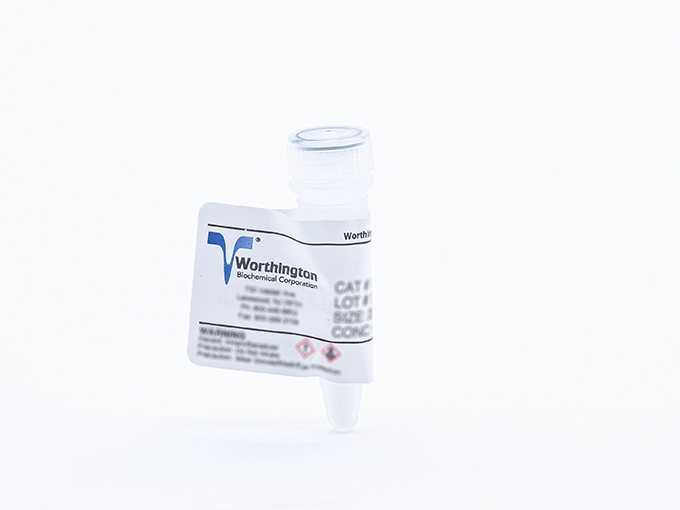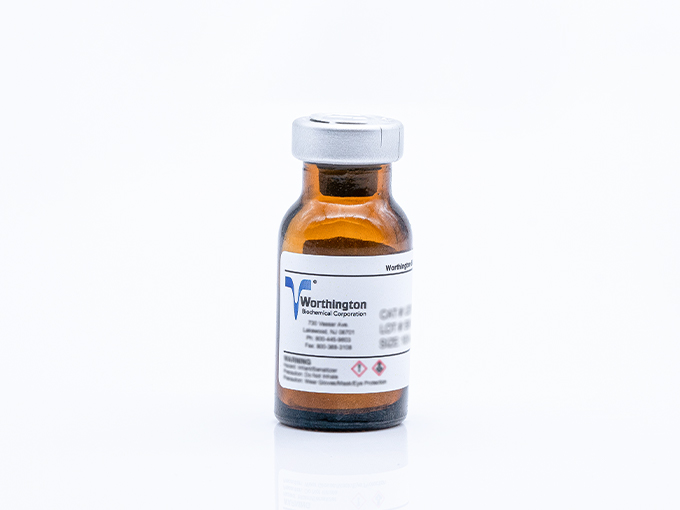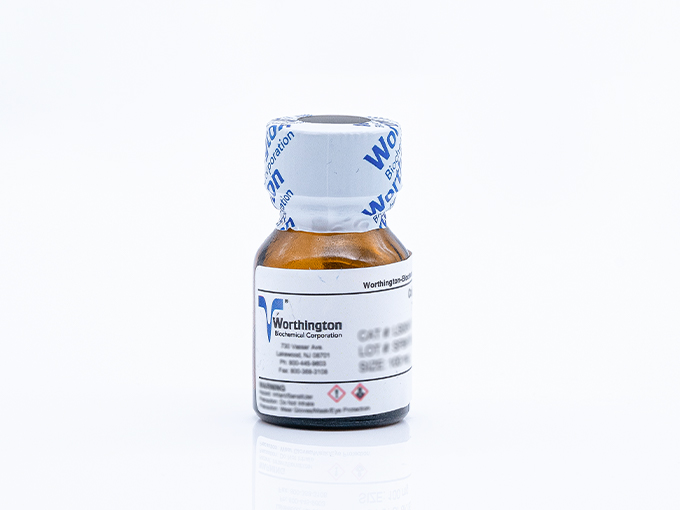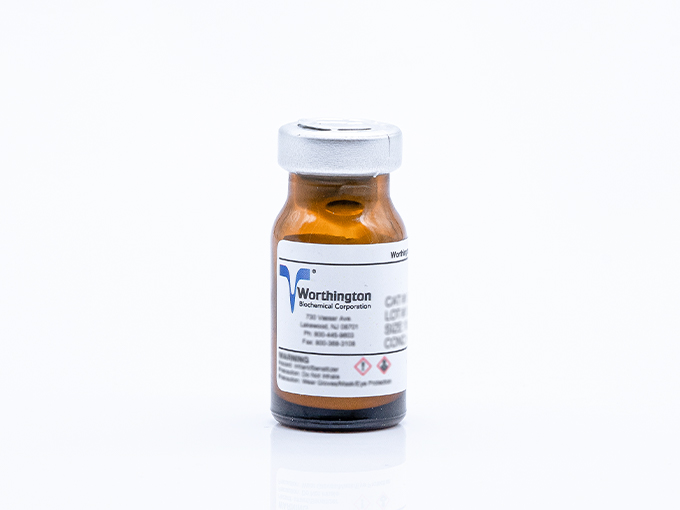Enzymes
Exploring Enzyme Catalysts and Their Diverse Applications
Enzymes are catalysts for numerous biochemical reactions. With our comprehensive array of enzymes spanning Hydrolases, Lyases, Oxidoreductases, and Transferases, we provide solutions for diverse biological and biochemical applications.
There are several groups of enzymes, each with specific functions and characteristics:
Oxidoreductases
Oxidoreductases is one of the six major classes of enzymes, governing oxidation-reduction reactions pivotal for energy production, metabolism, and detoxification. They are comprising subclasses such as Dehydrogenases, Hydroperoxidases, and Oxidases, each contributing distinct catalytic capabilities.
- Dehydrogenases catalyse the removal of hydrogen atoms from their substrates. They are involved in oxidation-reduction reactions and play key roles in energy metabolism. Examples include lactate dehydrogenase (LDH), which is important in cellular respiration and fermentation processes.
- Peroxidases catalyse the oxidation of various substrates and therefore play a critical role in cellular defence against oxidative stress.
- Oxidases catalyse oxidation reactions and therefore play crucial roles in biological processes, such as cellular respiration, metabolism, and the synthesis of vital molecules.
Hydrolases
Hydrolases represent a class central to hydrolytic cleavage reactions. Within this category, we cover a broad range, such as Glycosylases, Proteases, Phosphatases, Esterases, and Lipases. Within the group of Hydrolases, many enzymes are relevant for applications in the field of Molecular Biology, such as DNases, RNases, etc.
- Proteinases catalyse the cleavage (hydrolysis) of peptide bonds in proteins, leading to their breakdown into smaller peptides or amino acids. The enzyme class of Proteinases is often subdivided into Proteases and Peptidases. Proteases exhibit both endopeptidase (cutting within a peptide chain) and exopeptidase (cutting at the ends of a peptide chain) activity, while Peptidases primarily show exopeptidase activity. These enzymes play pivotal roles in cellular processes such as protein digestion, recycling, and cell cycle regulation. Their ability to break down proteins makes them indispensable tools for Proteomics studies, such as protein and peptide sequencing. Many proteases play pivotal roles in Tissue Dissociation for cell isolation, such as Collagenases, Trypsin and Papain.
- Esterases catalyse the hydrolysis of ester bonds in various organic compounds, including lipids, carbohydrates, and synthetic substrates. They play roles in lipid metabolism, signal transduction, and detoxification processes.
- Phosphatases catalyse the removal of phosphate groups from molecules, such as proteins, nucleotides, and sugars. They are involved in signal transduction, cell cycle regulation, and cellular metabolism.
- Glycosidases (also called glycoside hydrolases) catalyse the cleavage of glycosidic bonds, making them crucial for the repair of damaged DNA and the regulation of various cellular processes. Notably, we not only offer Lysozyme, a Glycosidase, but also the corresponding Lysozyme Substrate (Micrococcus lysodeikticus cells).
- Lipases are enzymes that catalyse the hydrolysis of lipids, breaking down triglycerides into fatty acids and glycerol. Their actions are essential for lipid digestion and metabolism in living organisms. Their ability to break down fats and oils makes them valuable tools for improving the efficiency of industrial processes and developing novel biotechnological applications.
Lyases
Lyases are enzymes that catalyse the cleavage of chemical bonds without the addition of water, facilitating reactions crucial for various metabolic pathways and synthetic processes.
Transferases
Transferases are enzymes that facilitate the transfer of functional groups, such as methyl, phosphate, or glycosyl groups, between molecules. Their diverse roles encompass crucial processes in metabolism, signal transduction, and the synthesis of biomolecules. From the modification of nucleic acids to the regulation of cellular metabolism, transferases play pivotal roles in cellular function and have significant applications in biotechnology, medicine, and the production of various biochemicals.
-
Galactose Oxidase - GAO
Cat.-Nr: LS004520
Supplied as a lyophilized powder containing sodium phosphate and sucrose as stabilizers.
-
Galactose Oxidase - GAO
Cat.-Nr: LS004522
Supplied as a lyophilized powder containing sodium phosphate and sucrose as stabilizers.
-
Galactose Oxidase - GAO
Cat.-Nr: LS004524
Supplied as a lyophilized powder containing sodium phosphate and sucrose as stabilizers.
-
Galactosidase, Beta, purified - BGC
Cat.-Nr: LS004099
Chromatographically purified. A suspension in 1.6M ammonium sulfate.
-
Galactosidase, Beta, purified - BGC
Cat.-Nr: LS004100
Chromatographically purified. A suspension in 1.6M ammonium sulfate.
-
Glucose-6-Phosphate Dehydrogenase, High-Activity, Suspension
Cat.-Nr: LS004002
Chromatographically purified for higher specific activity. Same as Code: ZF except assayed using NAD. Phosphohexose isomerase, phosphogluconate... Read More
-
Glucose-6-Phosphate Dehydrogenase, High-Activity, Suspension
Cat.-Nr: LS004004
Chromatographically purified for higher specific activity. Same as Code: ZF except assayed using NAD. Phosphohexose isomerase, phosphogluconate... Read More
-
Glucose-6-Phosphate Dehydrogenase, lyoph. - ZFL
Cat.-Nr: LS003980
Chromatographically purified. Phosphohexose isomerase, phosphogluconate dehydrogenase, adenylate kinase and creatine phosphokinase contaminant... Read More
-
Glucose-6-Phosphate Dehydrogenase, lyoph. - ZFL
Cat.-Nr: LS003981
Chromatographically purified. Phosphohexose isomerase, phosphogluconate dehydrogenase, adenylate kinase and creatine phosphokinase contaminant... Read More
-
Glucose-6-Phosphate Dehydrogenase, lyoph. - ZFLD
Cat.-Nr: LS003997
Chromatographically purified. Same as Code: ZFL except assayed using NAD. Phosphohexose isomerase, phosphogluconate dehydrogenase, adenylate kinase... Read More
-
Glucose-6-Phosphate Dehydrogenase, lyoph. - ZFLD
Cat.-Nr: LS003998
Chromatographically purified. Same as Code: ZFL except assayed using NAD. Phosphohexose isomerase, phosphogluconate dehydrogenase, adenylate kinase... Read More
-
Glucose-6-Phosphate Dehydrogenase, susp. - ZF
Cat.-Nr: LS003983
Chromatographically purified. A suspension in 3.7M ammonium sulfate. Phosphohexose isomerase, phosphogluconate dehydrogenase, adenylate kinase and... Read More
-
Glucose-6-Phosphate Dehydrogenase, susp. - ZF
Cat.-Nr: LS003985
Chromatographically purified. A suspension in 3.7M ammonium sulfate. Phosphohexose isomerase, phosphogluconate dehydrogenase, adenylate kinase and... Read More
-
Glucose-6-Phosphate Dehydrogenase, susp. - ZFD
Cat.-Nr: LS003992
Chromatographically purified. Same as Code: ZF except assayed using NAD. Phosphohexose isomerase, phosphogluconate dehydrogenase, adenylate kinase... Read More
-
Glucose-6-Phosphate Dehydrogenase, susp. - ZFD
Cat.-Nr: LS003993
Chromatographically purified. Same as Code: ZF except assayed using NAD. Phosphohexose isomerase, phosphogluconate dehydrogenase, adenylate kinase... Read More
-
Hexokinase, lyoph. - HKQL
Cat.-Nr: LS002511
Chromatographically purified. A lyophilized powder containing ~30% buffer/stabilizer. Phosphohexose isomerase, 6-phosphogluconate dehydrogenase,... Read More
-
Hexokinase, lyoph. - HKQL
Cat.-Nr: LS002512
Chromatographically purified. A lyophilized powder containing ~30% buffer/stabilizer. Phosphohexose isomerase, 6-phosphogluconate dehydrogenase,... Read More
-
Hydroxysteroid Dehydrogenase - STDH
Cat.-Nr: LS004915
A lyophilized powder obtained from induced cells. Contains both alpha and beta activities.Store at -20°C. =0.03 units per mg dry weight
-
Hydroxysteroid Dehydrogenase - STDH
Cat.-Nr: LS004916
A lyophilized powder obtained from induced cells. Contains both alpha and beta activities.Store at -20°C. =0.03 units per mg dry weight
-
L-Amino Acid Oxidase - LAO
Cat.-Nr: LS002763
An aqueous solution with toluene added as a preservative.
-
L-Amino Acid Oxidase - LAO
Cat.-Nr: LS002764
An aqueous solution with toluene added as a preservative.
-
Lactate Dehydrogenase, lyoph. - LADCL
Cat.-Nr: LS002756
Chromatographically purified. A lyophilized powder.
-
Neuraminidase, purified - NEUA
Cat.-Nr: LS004759
Chromatographically purified. A lyophilized powder containing 50% (w/w) sucrose. Contaminating proteolytic activity ≤0.1% using trypsin as the... Read More
-
Neuraminidase, purified - NEUA
Cat.-Nr: LS004761
Chromatographically purified. A lyophilized powder containing 50% (w/w) sucrose. Contaminating proteolytic activity ≤0.1% using trypsin as the... Read More
-
Neuraminidase, purified - NEUA
Cat.-Nr: LS004762
Chromatographically purified. A lyophilized powder containing 50% (w/w) sucrose. Contaminating proteolytic activity ≤0.1% using trypsin as the... Read More
-
Pectinase - PASE
Cat.-Nr: LS004297
A chromatographically purified preparation also containing hemicellulase, cellulase, pectin-esterase and xylanase activities. Suitable for plant... Read More
-
Pectinase - PASE
Cat.-Nr: LS004298
A chromatographically purified preparation also containing hemicellulase, cellulase, pectin-esterase and xylanase activities. Suitable for plant... Read More
-
Peroxidase, EIA Grade, purified - HPOFF
Cat.-Nr: LS006474
Chromatographically purified. Single basic isozyme with RZ ≥2.9. A lyophilized powder. Suitable for immunoconjugation.
-
Peroxidase, EIA Grade, purified - HPOFF
Cat.-Nr: LS006476
Chromatographically purified. Single basic isozyme with RZ ≥2.9. A lyophilized powder. Suitable for immunoconjugation.
-
Phospholipase A2 - PLA
Cat.-Nr: LS005660
A chromatographically purified, dialyzed, lyophilized powder.
-
Plasma Amine Oxidase - PAO
Cat.-Nr: LS003113
Chromatographically purified through step five of the procedure of Yamada, Y., and Yasunobu, K., JBC, 237, 1511 (1962). A lyophilized powder. (One IU... Read More
-
Plasma Amine Oxidase - PAO
Cat.-Nr: LS003114
Chromatographically purified through step five of the procedure of Yamada, Y., and Yasunobu, K., JBC, 237, 1511 (1962). A lyophilized powder. (One IU... Read More




